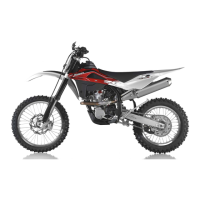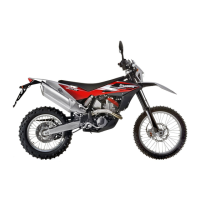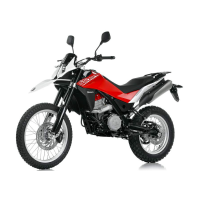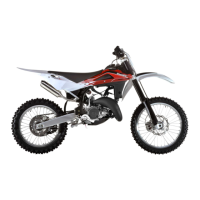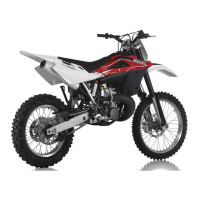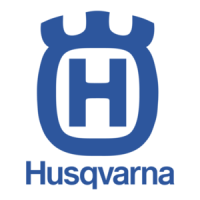
Do you have a question about the Husqvarna 2013 TE 250R and is the answer not in the manual?
| Brand | Husqvarna |
|---|---|
| Model | 2013 TE 250R |
| Category | Motorcycle |
| Language | English |
Lists the specific models covered by the manual starting from their serial numbers.
Provides recommendations for preventing problems and ensuring effective service work.
Outlines essential practices for workshop technicians to follow during maintenance and repair.
Details vehicle configuration requirements for warranty validity, emphasizing standard configuration.
Lists the topics covered in the General Information section with their respective page references.
Details periodic maintenance tasks, checks, and replacements required at specific service intervals.
Addresses common engine issues such as starting problems, stalling, noise, and low power.
Lists potential causes and remedies for clutch slippage and operational difficulties.
Details reasons for reduced engine power and corresponding solutions.
Explains why the engine might overheat and provides troubleshooting steps.
Diagnoses causes for stiff handlebar movement and suggests corrective actions.
Identifies potential causes of handlebar vibration and offers solutions.
Addresses issues with suspension damping being too stiff and provides adjustment or remedy steps.
Troubleshoots suspension damping that is too soft, suggesting checks and adjustments.
Helps diagnose and resolve issues causing front or rear wheel shaking.
Identifies sources of noise in the rear suspension and suggests remedies.
Addresses braking system issues, including air in the lines, low fluid, and worn components.
Provides causes and solutions for spark plugs fouling quickly, often related to engine condition.
Discusses potential reasons for spark plug electrode overheating and necessary adjustments.
Troubleshoots issues with the charging system, pointing to potential problems with cables, regulator, or coil.
Addresses the problem of the generator overcharging the battery, usually indicating a faulty voltage regulator.
Guides on diagnosing why the battery is not holding charge, including checking terminals and the battery itself.
Lists common causes for starter motor failure, such as a flat battery, faulty switches, relays, or the motor itself.
Lists the various adjustment and setting procedures covered in the Settings and Adjustments section with page numbers.
Details the step-by-step process for removing the motorcycle's saddle.
Provides instructions for safely removing the fuel tank, emphasizing careful handling of fuel lines.
Details the procedure for checking and adjusting valve clearances, crucial for engine performance.
Explains how to adjust the throttle cable to ensure correct free play and smooth operation.
Guides on how to adjust the engine's idle speed for optimal running conditions.
Outlines the procedure for replacing worn clutch plates to restore clutch performance.
Covers adjusting the hydraulic clutch lever and checking its fluid level for proper operation.
Explains how to adjust the front brake lever free play and check the master cylinder fluid level.
Describes how to adjust the rear brake pedal's position for rider comfort and accessibility.
Details the procedure for adjusting the free play in the rear brake pedal.
Explains how to check the brake fluid level in the rear brake master cylinder reservoir.
Provides instructions on how to check the engine oil level, a critical maintenance task.
Covers the process of changing engine oil and cleaning or replacing the oil filters.
Explains how to check the coolant level in the radiator, essential for preventing engine overheating.
Details the procedure for replacing the engine coolant, including draining and refilling steps.
Describes how to inspect the air filter on TC models for dirt and debris.
Details the inspection process for the air filter on TE and TXC models.
Provides instructions for cleaning the air filter using specified detergents and oils.
Guides on the correct procedure for reassembling the air filter into its housing, ensuring proper sealing.
Explains how to check, adjust, and lubricate the drive chain for optimal performance and longevity.
Provides instructions on how to properly lubricate the drive chain, emphasizing the correct lubricant and avoiding contamination.
Details the process for removing and cleaning the drive chain when it is particularly dirty.
Specifies methods for washing drive chains that do not have O-rings, common on TC models.
Guides on lubricating chains without O-rings, suggesting specific lubricants.
Provides instructions for washing drive chains that are equipped with O-rings, typical for TE-TXC models.
Details the proper method for lubricating O-ring chains, ensuring longevity and smooth operation.
Offers guidelines for adjusting suspension settings based on different terrain types and riding conditions.
Explains how to adjust the rear shock absorber's spring preload to suit rider weight and terrain.
Details the procedure for adjusting the spring preload on the shock absorber for optimal suspension setup.
Covers the adjustment of compression and rebound damping on the shock absorber for fine-tuning suspension response.
Provides information on the standard spring rates for the shock absorber on different models.
Explains how to adjust the compression and rebound damping on the Kayaba front fork.
Provides instructions for bleeding the front fork to remove air, which is necessary after disassembly or for maintenance.
Details the process for adjusting the steering bearings to ensure free and play-free handlebar movement.
Describes how to modify the steering angle using adjuster assemblies on the steering head.
Guides on inspecting the fuel supply hoses for potential issues, especially during fuel tank removal.
Explains how to visually inspect the exhaust system for gas leaks and damaged components.
Lists the various disassembly and removal procedures covered in the General Procedures section.
Introduces the section describing operations preliminary to engine removal, noting partial disassembly may be needed.
Details the process for removing the motorcycle saddle.
Explains how to remove the side panels of the motorcycle.
Guides on how to safely remove the battery from TE-TCX models.
Provides instructions for removing the rear chassis, mudguard, and air box on TC models.
Details the process for removing the rear chassis, mudguard, and air box on TE-TXC models.
Outlines the procedure for removing the exhaust system from TC models, including key components.
Describes the process of removing the fuel tank, scoops, and spoilers on TC models.
Outlines the procedure for removing the fuel pump from TC model motorcycles.
Details the steps for removing the fuel pump from TE-TXC model motorcycles.
Explains how to remove the start-up relay from TE-TXC models.
Provides instructions for removing the condenser, emphasizing safety precautions.
Details the process for removing the Electronic Control Unit (ECU) on CDI systems.
Guides on how to remove the voltage regulator on TE-TXC models.
Outlines the procedure for removing the voltage regulator on TC models.
Describes the process of removing the ignition coil or stick-coil, including necessary precautions.
Details how to remove the clutch hose, including draining residual oil and bleeding the system later.
Explains how to remove the horn on TE models, including disconnecting electrical connectors.
Guides on how to remove the electric cooling fan on TE-TXC models.
Provides instructions for removing the secondary drive chain, applicable to both O-ring and non-O-ring types.
Details the comprehensive procedure for removing the engine from the motorcycle chassis.
Outlines the steps for removing the engine radiators, including draining coolant and disconnecting hoses.
Explains how to remove the thermostat from the cooling system on TE-XC models.
Lists the engine disassembly procedures and their corresponding page numbers for navigation.
Illustrates and identifies the major components of the engine for TE and TXC models.
Identifies and illustrates the key components of the motorcycle engine.
Details the procedure for removing the cylinder head cover, including loosening screws and removing the gasket.
Explains how to remove the camshafts, including preparing the engine by setting the piston to TDC and noting reference marks.
Guides on removing the water pump body from the engine cylinder head.
Details the step-by-step disassembly of the water pump, including impeller, oil seal, and bearing removal.
Describes the process of removing the cylinder head, including prior steps like removing head cover and camshafts, and chain tensioner removal.
Details the procedure for removing valves, including lifting rocker arms, removing pads, and loosening plugs.
Explains how to remove the cylinder and its gasket, including freeing the timing chain.
Details the process of removing the piston, including removing the pin retaining rings and the piston pin.
Outlines the procedure for removing the flywheel, including loosening the rotor nut and using a puller.
Describes how to remove the kick start pedal, including the retaining bolt and washer.
Details the process of removing the sprocket, including loosening the nut and removing the spacer.
Explains how to remove the oil filter cover, filter, and Belleville washer.
Guides on how to remove the clutch cover, including screws, gasket, and bushings.
Details the process of disassembling the clutch, including removing springs, pressure plate, and actuator plate.
Describes how to remove the slider using an Allen wrench.
Guides on disassembling the kick start mechanism, including releasing the spring and removing the shaft assembly.
Details the procedure for removing the starter motor on TE-TXC models, including exhaust pipe removal and power cable disconnection.
Separates the starter motor from its drive assembly.
Details the disassembly of the starter drive assembly.
Guides on disassembling the oil pump, including removing the pump body, rotors, and drive gear.
Details the removal of the gear shift pedal and the entire selector assembly.
Explains how to remove the primary drive gear and the water pump drive gear.
Details the process of disassembling the crankcase, including removing screws and noting their lengths.
Guides on disassembling the gearbox, starting with the output shaft shifter forks.
Outlines the procedure for removing the crankshaft from the crankcase assembly.
Lists the engine overhaul procedures and their corresponding page numbers for navigation.
Provides instructions for cleaning engine parts using gasoline and compressed air, with safety precautions.
Explains the importance of clearances for engine performance and wear, and how to check them.
Details how to clean the cylinder head and check for warpage, a critical step in engine overhaul.
Describes the procedure for refacing valve seats if they show signs of wear or damage, specifying measurements.
Guides on inspecting valves for wear, pitting, or distortion, and checking stem runout and head out-of-round.
Explains how to check valve springs for free length and replace them if they exceed the service limit.
Details how to check rocker arms for free oscillation, ensuring proper valve train operation.
Provides step-by-step instructions for installing valves, including lubrication, spring compression, and collet fitting.
Explains how to check valves for proper sealing before assembling the cylinder head to the engine.
Guides on inspecting camshaft lobes for wear, scoring, or distortion and checking bearing alignment.
Details checking timing chain and gears for wear and wear limits, recommending replacement if necessary.
Advises on when to replace timing chain tensioners based on wear material.
Explains how to check cylinder walls for scuffing, measure bore diameter, taper, and out-of-round.
Guides on cleaning the piston, inspecting for damage, and checking its dimensions.
Details how to measure cylinder and piston diameters to calculate clearance, a critical factor for engine health.
Specifies how to measure the piston diameter accurately for clearance calculations.
Instructs on inspecting the piston pin for smoothness and signs of wear or damage.
Advises on inspecting piston rings for forcing or scoring and notes that replacement pistons come with rings.
Details how to measure piston ring end gap and clearance in the cylinder bore.
Explains how to measure the axial clearance of piston rings within their grooves.
Guides on measuring the clearance between the piston pin and the connecting rod's small end.
Details how to measure the side clearance of the connecting rod's big end.
Explains how to measure the axial clearance between the crankshaft and the connecting rod.
Instructs on inspecting the crankshaft's main journals, threads, keyways, and splines for good condition.
Describes how to check the crankshaft for straightness using dial gauges and specifies the service limit.
Guides on inspecting all clutch components for wear and damage, measuring friction plate thickness and pack thickness.
Explains how to measure clearance between friction plates and clutch housing, and when to replace parts.
Details how to measure the free length of clutch springs and when replacement is necessary.
Guides on checking these clutch components for wear or failure and replacing them if needed.
Instructs on checking the clutch hub's steel plate slots for wear or failure.
Details checking the clutch housing's friction plate slots and needle roller bearing seats for wear.
Guides on checking the primary drive gear teeth for wear or failure.
Guides on disassembling the oil pump, including checking gears and rotors for wear.
Guides on inspecting shifter forks for bends, checking gear groove clearance, and identifying components needing replacement.
Instructs on checking the selector drum grooves for wear or damage.
Details checking drive bushings for out-of-roundness and ensuring free movement.
Lists all engine reassembly procedures and their page numbers.
Provides general reassembly instructions, emphasizing reversing disassembly steps and replacing specific parts.
Details assembly and lubrication steps for the crank, alternator, and left crankcase half.
Lists the specified torque values for various fasteners related to the crank, alternator, and left crankcase.
Details the assembly and lubrication procedures for the 5-speed gearbox and gear shift control.
Lists the specified torque values for fasteners related to the 5-speed gearbox and gear shift control.
Details the assembly and lubrication procedures for the 6-speed gearbox and gear shift control.
Lists the specified torque values for fasteners related to the 6-speed gearbox and gear shift control.
Details assembly and lubrication steps for the clutch, kick start, and right crankcase half.
Lists torque values for fasteners related to clutch, kick start, and right crankcase assembly.
Details the assembly and lubrication for the right crankcase cover.
Lists torque values for fasteners related to the right crankcase cover assembly.
Details assembly and lubrication for the head, cylinder, piston, timing system, water pump, and spark plug on TC models.
Lists torque values for head, cylinder, piston, timing system, water pump, and spark plug assembly.
Illustrates the components and assembly of the 5-speed input shaft.
Illustrates the components and assembly of the 5-speed output shaft.
Details the fitting sequence and lubrication for the 5-speed input shaft components.
Provides step-by-step instructions for fitting the 5-speed output shaft components, including lubrication and engagement checks.
Illustrates the components and assembly of the 6-speed input shaft.
Illustrates the components and assembly of the 6-speed output shaft.
Details the fitting sequence and lubrication for the 6-speed input shaft components.
Guides on assembling the crankcase halves, including bearing installation and tightening procedures.
Continues crankcase assembly, focusing on installing the input/output shaft assembly and shifter forks.
Continues crankcase assembly, covering selector drum installation and testing gearbox operation.
Continues crankcase assembly, installing crankshaft bearings and applying sealant to the mating surface.
Completes crankcase assembly, involving heating and installing bearing housings, joining halves, and tightening screws.
Details the installation of the gear shift control components, including spring abutment pin, ratchet, and selector drum.
Continues gear shift assembly, covering ratchet assembly fitting and testing gearbox operation.
Completes gear shift assembly by checking lever shaft and installing the gear shift lever.
Guides on refitting the kick start components, including the starter ratchet release plate and shaft assembly.
Details the installation of the timing chain slider, oil pump drive gear, and primary drive gear.
Continues the assembly process by installing the timing chain, bushing, and clutch housing.
Completes the timing chain and primary drive assembly by placing a dummy gear and tightening the primary drive shaft nut.
Outlines the steps for assembling the clutch, including installing washer, hub, lock washer, nut, and pressure plate.
Continues clutch assembly, covering refitting plates, actuator plate, and tightening spring screws.
Guides on installing the oil seal retaining plate and the sprocket, including tightening the nut and bending lock washer tabs.
Details the installation of the flywheel rotor, needle roller bearing, thrust ring, and freewheel for TE-TXC models.
Continues the installation by refitting the rotor, tightening the nut, and assembling the starter motor with its gasket.
Explains the process of installing the flywheel rotor on TC models, including tightening the nut.
Provides instructions for fitting piston rings, noting orientation and ensuring correct placement.
Details the process of installing the piston into the cylinder, including gasket and locating pin checks.
Continues the piston and cylinder installation, covering lubrication, chain collection, and slider positioning.
Continues the process by fitting screws and spacers to secure the cylinder liner and measuring piston faces to select the head gasket.
Provides a table to help select the appropriate cylinder head gasket based on piston measurements.
Details the procedure for installing the cylinder head, including tightening screws and refitting the water temperature sensor.
Continues cylinder head installation, covering bearing checks, gear timing, and O-ring greasing.
Guides on refitting the chain tensioner, tightening screws, and releasing the tensioner.
Details the process of installing the water pump, including gasket fitting and engaging the pump gear.
Explains how to install the camshafts, including bearing checks, crankshaft rotation, and reference mark alignment.
Continues camshaft installation, covering mount tightening and checking valve clearances.
Guides on installing the flywheel cover, including stator mounting, retaining screws, and cable routing.
Details how to refit the spark plug and its associated connectors.
Explains how to install the starter motor seat cover on TC models.
Guides on refitting the cylinder head cover, spark plug, and ignition coil.
Details the assembly of the right crankcase, including refitting the oil pump drive gear, stub, and centring bushings.
Continues right crankcase assembly, covering refitting the gasket, oil filter, and tightening crankcase screws.
Describes fitting the oil filter and tightening the cap on 250cc models.
Guides on fitting the blow-by tube and filter on 310cc models.
Details refitting the oil feed hose and tightening the associated drilled screws.
Explains how to install the gear shift pedal and the kick start pedal, including tightening screws and checking for clearance.
Guides on installing the engine back into the chassis and reassembling all removed parts.
Lists the topics related to the front suspension, including fork removal and service instructions.
Provides detailed service instructions for the Ø48USD Kayaba front fork, covering general operation and components.
Describes the front suspension for TC and TXC models, highlighting the Kayaba fork and wheel travel.
Lists and identifies the numbered components of the front suspension diagram for TC and TXC models.
Details the process for removing the front fork legs, including cap nut loosening, oil draining, and adjuster screw removal.
Continues fork removal by taking the cartridge out of the outer tube and removing the bottom valve assembly.
Continues fork removal by draining excess oil, removing dust seal and retaining ring, and separating inner and outer tubes.
Continues fork removal by removing sealing rings, metal rings, checking rebound adjuster rod, and removing the bottom valve assembly.
Continues fork reassembly by reassembling sealing rings and metal parts on the inner tube and fitting the outer tube components.
Continues fork reassembly by fitting the dust seal, refitting the cartridge, and filling it with oil.
Continues fork assembly by checking oil level, installing the bottom valve assembly, and tightening it.
Continues fork assembly by draining excess oil, cleaning the cartridge, and inserting it into the inner tube.
Continues fork assembly by pushing down the inner tube, inserting the rebound adjuster rod, and tightening adjuster and nut.
Continues fork assembly by clamping the wheel axle carrier, tightening the adjuster screw, filling the outer tube with oil, and tightening the cylinder.
Describes the front suspension system for TE models, highlighting the Kayaba fork and wheel travel.
Lists and identifies the numbered components of the front suspension diagram for TE models.
Continues the front fork removal process by loosening cap nuts, fork cap nut, and removing top cap nut, spring retainer, and rebound adjuster rod.
Continues fork removal by removing the nut, spring guide, O-ring, collar bushing, and bottom valve assembly.
Continues fork removal by taking the cartridge out of the outer tube and removing the dust seal.
Continues fork removal by removing the retaining ring, separating inner and outer tubes, removing sealing rings, and checking rebound adjuster rod.
Continues fork removal by checking the spring, inner tube, and outer tube for damage or distortion.
Continues fork reassembly by mounting sealing rings and metal parts on the inner tube, and fitting outer tube components.
Continues fork reassembly by inserting the cartridge into the outer tube and tightening the bottom valve assembly.
Continues fork assembly by fitting collar bushing, O-ring, spring guide, and nut, then filling the damper unit with oil.
Completes fork assembly by filling the damper unit with oil, pumping the piston rod, and tightening the cap nuts.
Lists the topics related to rear suspension, including shock absorber, linkage, and chain maintenance.
Provides tightening torque figures for the rear shock absorber mounting bolts.
Indicates lubrication points for the rear suspension components, specifying where to apply grease.
Describes the rising-rate rear suspension system, including shock absorber, linkage, and swingarm.
Details the procedure for removing the rear shock absorber, including preparatory steps and bolt removal.
Guides on removing and servicing the swinging arm, including chain, brake line, and wheel axle removal, and checking components for wear.
Explains how to check the swinging arm shaft for taper and distortion using a dial gauge.
Details how to check the drop link and drag link for radial and axial clearance and inspect associated parts for wear.
Guides on checking the wear of chain roller, guide, and slider, and checking chain guide alignment.
Lists the topics related to the braking system, including bleeding and fluid changes.
Illustrates the front and rear braking systems, identifying key components like master cylinders, calipers, and discs.
Details how to check the brake discs for wear, corrosion, scoring, and warpage, and the procedure for disc removal.
Guides on checking brake pad wear, identifying the service limit, and the procedure for replacing pads.
Details the steps for removing brake pads, including clips and pins.
Explains how to install new brake pads and reassemble the caliper, noting that bleeding may not be necessary.
Provides a detailed procedure for bleeding air from the front braking system to restore lever feel.
Details the step-by-step process for bleeding air from the rear braking system to resolve a spongy pedal feel.
Outlines the procedure for changing brake fluid, including safety precautions and replacement steps.
Lists the various topics related to the electrical system, including wiring diagrams, component locations, and troubleshooting.
Illustrates the electrical wiring layout for TC models, identifying components and connections.
Lists and identifies the numbered components shown in the wiring diagram for TC models.
Explains the color codes used for wires in the wiring diagrams.
Presents the electrical wiring diagram for TE models, detailing component connections and functions.
Provides the electrical wiring diagram for TXC models, illustrating component connections and layout.
Shows the physical location of key electrical components on TC model motorcycles.
Identifies the locations of various electrical components on TE model motorcycles.
Shows the physical location of key electrical components on TXC model motorcycles.
Lists the various elements that constitute the motorcycle's electrical system, such as fuses, relays, and sensors.
Details how to measure the resistance of the generator stator windings to check for faults.
Provides performance data for the generator under no-load conditions for both TE-TXC and TC models.
Explains the function of the ECU and sensors in the ignition and starter system for TC models.
Describes the ignition and starter system for TE-TXC models, detailing ECU function and sensor inputs.
Explains the components of the charging system for TE-TXC models and their functions.
Illustrates the wiring diagram for the charging system on TE-TXC models.
Provides information on the TE-TXC battery, including maintenance and storage recommendations.
Details how to access the battery and perform charging procedures, including connection order and voltage checks.
Guides on checking the regulated voltage output from the charging system on TE-TXC models.
Explains how to test the voltage regulator on TE-TXC models and when to replace it.
Outlines the procedure for checking the voltage regulator on TC models and when replacement is needed.
Describes the function of the voltage regulator, including its role in rectifying generator output and adjusting charging voltage.
Details how to remove and inspect the starter motor, including continuity checks and applying Loctite.
Provides basic specifications for the starter motor, including rated voltage and power.
Outlines the procedure for testing the starter motor under no-load conditions.
Details the procedure for testing the starter motor under cranking load.
Presents graphical data for starter motor performance tests on TE-TXC models.
Guides on inspecting the solenoid starter, including disconnecting cables and checking resistance.
Provides the standard resistance value for the starter relay and its wiring diagram.
Details how to measure the primary and secondary winding resistance of the ignition coil and terminal cap resistance.
Explains how to test the thermo-switch using a tester and hot water, specifying temperature thresholds for fan operation.
Describes the function of the ECU and the procedure for its removal.
Provides guidance on checking the spark plug gap, cleaning, inspecting, and proper installation torque.
Provides information on the TE-TXC battery, including maintenance and storage recommendations.
Details how to access the battery and perform charging procedures, including connection order and voltage checks.
Explains how to adjust the headlamp beam for proper visibility and road safety.
Guides on how to access and replace the headlamp bulbs, including parking light bulb replacement.
Details the procedure for removing and replacing the tail light assembly.
Explains how to replace the bulb for the number plate illumination.
Guides on checking the continuity of handlebar switches and replacing faulty parts.
Identifies the engine stop switch on the left-hand handlebar for TC models.
Describes the controls on the left-hand handlebar commutator for TE models, including turn signals and horn.
Identifies the engine start button on the right-hand switch for TE-TXC models.
Provides instructions for checking and replacing fuses, emphasizing troubleshooting the cause of a blown fuse.
Offers a caution regarding handling semiconductor parts like the ECU and voltage regulator to prevent damage.
Details how to test relays for proper operation using a multimeter and a power supply.
Explains the digital instrument panel and its warning lights on TE models.
Provides additional notes regarding the dashboard's behavior and activation.
Lists the different functions available on the instrument display.
Explains how to switch between kilometers and miles for speed and odometer readings.
Describes how to set the motorcycle's clock.
Explains how to reset the trip meter.
Details how to activate and reset the LPT (miles/kilometers covered time) function.
Explains how to activate and use the hour counter function.
Explains the function of the FI Lamp for indicating engine or injection system malfunctions on TE-TXC models.
Provides important information regarding the FI Lamp and the need for a diagnosis instrument.
Guides on how to remove and refit the dashboard assembly on TE models.
Provides a problem-solving guide for common electrical system issues.
Lists the topics related to engine cooling, including coolant level checks and system overhauls.
Explains how to check the coolant level, emphasizing critical steps for safety and proper system operation.
Illustrates the cooling system components for TC models, including radiators, pump, and hoses.
Details the process for overhauling the engine cooling system on TC models, including radiator and hose checks.
Illustrates the cooling system components for TE-TXC models, showing radiators, pump, thermostat, and hoses.
Lists the topics related to the hydraulic clutch system, including fluid checks and bleeding procedures.
Describes the hydraulic clutch system, its components, and how it operates to disengage the clutch.
Details the procedure for draining the clutch fluid, including hose and reservoir cap removal.
Guides on servicing the clutch master cylinder, including disassembly, seal replacement, and reassembly.
Provides a comprehensive procedure for bleeding air from the hydraulic clutch system to ensure proper operation.
Lists the procedures related to the fuel injection system, including fuel feeding and pump tests.
Explains the components and operation of the fuel injection system, listing parameters affecting fuel delivery.
Provides instructions for using the "HUSQVARNA SERVICE TOOL" for diagnosing fuel injection system malfunctions.
Details the procedure for testing the fuel pump on TE-TXC models, including connecting to a power supply.
Explains how to test the fuel pump on TC models, including checking the fuel reserve sensor and pump operation.
Provides a list of specialized tools with their part numbers, categorized for ease of reference.
Lists tightening torque specifications for various engine components, including cylinder head and drive/transmission parts.
Lists torque specifications for electrical system components like stator and regulator.
Provides torque values for clutch components such as hub and pressure plate.
Lists torque specifications for starter motor and related parts.
Includes torque figures for the gearbox sprocket.
Lists torque specifications for gear shift control components.
Provides torque values for water pump and cover fasteners.
Lists torque specifications for handlebar and control components.
Lists torque specifications for front suspension components.
Lists torque specifications for rear suspension components.
Lists torque specifications for fairings and mudguards.
Lists torque specifications for electrical system components.
Lists torque specifications for fuel system components.
Lists torque specifications for wheels and brakes.
Lists torque specifications for exhaust system components.
Lists torque specifications for instrument components.
Lists torque specifications for cooling system components.
Provides general torque values based on thread size for various applications.
Lists the topics related to the chassis and wheels, including front and rear wheel servicing and chain checks.
Describes the construction of the motorcycle frame, including material and section details.
Identifies lubrication points on the chassis and checks for cracks or damage on various assemblies.
Illustrates the components of the front wheel assembly, with a key identifying each part.
Provides a key to identify the numbered components of the front wheel diagram.
Details the procedure for removing the front wheel, including loosening axle bolts and brake caliper.
Guides on refitting the front wheel, including spacer installation, axle fitting, and tightening procedures.
Explains how to check the gap between the magnet and sensor for the speed sensor on TE models.
Illustrates the components of the rear wheel assembly, with a key identifying each part.
Provides a key to identify the numbered components of the rear wheel diagram.
Details the procedure for removing the rear wheel, including unscrewing the axle nut and extracting the wheel.
Guides on checking and replacing wheel hub bearings, and fitting new bearings with special installers.
Explains how to check the wheel axle for warpage and when it needs straightening or replacement.
Provides the standard and maximum limits for axle runout.
Instructs on tightening wheel nipples and checking spoke tension by sound.
Reports the allowed limits for wheel rim warpage (runout and out-of-round) and when to replace bearings or the rim.
Guides on checking the wear of the rear chain sprocket, drive sprocket, and chain, and when to replace them as a set.
Provides the specified torque for the rear sprocket retaining screws.
Details how to check the transmission sprocket for damage or wear and addresses wheel misalignment issues.
